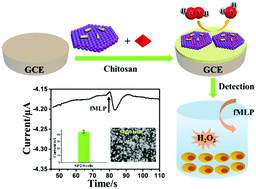MoS2 nanosheet–Au nanorod hybrids for highly sensitive amperometric detection of H2O2 in living cells†
Abstract
MoS2 nanosheet–Au nanorod (MoS2–Au) hybrids were utilized to immobilize catalase (CAT) to construct a sensitive hydrogen peroxide (H2O2) electrochemical biosensor for the reliable determination of H2O2 released from living cells. The fabricated biosensor was characterized by transmission electron microscopy (TEM), UV-Vis spectroscopy, Fourier transform infrared spectroscopy (FT-IR) and Raman spectroscopy, it was observed that the MoS2–Au hybrid provides excellent matrixes for the adsorption of CAT and the entrapped CAT maintains its native structure and bioactivity. The results of direct electrochemical measurements indicate that on the CAT/MoS2–Au modified electrode, CAT exhibits a surface controlled and fast electron transfer process towards H2O2 reduction. The MoS2–Au hybrid has a large surface area and provides a biocompatible microenvironment for accelerating direct electron transfer between the enzyme and the electrode. The detection limit of the constructed H2O2 biosensor is 1 × 10−7 M (signal-to-noise = 3) with a wide linear range from 5 × 10−7 M to 2 × 10−4 M and a high sensitivity of 187.4 mA M−1 cm−2. The fabricated H2O2 biosensor also exhibits excellent selectivity, good reproducibility and long-time stability. Furthermore, the biosensor was used to perform real-time monitoring of H2O2 released from SP2/0 cells, indicating the MoS2–Au hybrid is an attractive material for application in the efficient immobilization of biomolecules and construction of high-performance biosensors.

- This article is part of the themed collection: JMC B Editor’s choice web collection: ‘‘seeing the unseen updated: advances in biosensing’’


 Please wait while we load your content...
Please wait while we load your content...